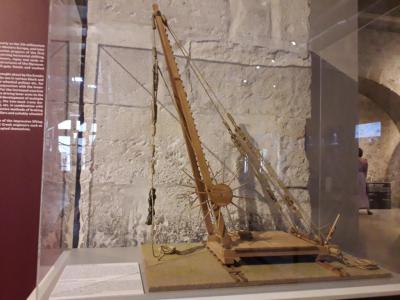
Kotsanas Museum of Ancient Greek Technology, Heraklion
Situated within the historic confines of the Venetian building "Palazzo d’ Ittar", the Kotsanas Museum of Ancient Greek Technology stands as a captivating testament to the innovative and ingenious aspects of ancient Greek technology.
The museum's flagship exhibition, titled "Ancient Greece - The Origins of Technologies," unveils a lesser-known facet of the ancient world through approximately 75 distinctive objects with innovative technological profiles. Among the notable artifacts showcased are the automatic servant, recognized as the world's first robot, and the automatic theater of Philon.
Visitors can marvel at the hydraulic clock of Ktesibios and the famed Antikythera Mechanism, often hailed as the world's first computer. The exhibition seamlessly blends contemporary display tools with a team-oriented approach, fostering an environment where visitors can delve into the fascinating realm of Ancient Technology and its enduring influence on modern advancements.
The museum ensures accessibility for both Greek and English-speaking audiences, providing audiovisual material and explanatory texts in multiple languages. Engaging workshops, conferences, meetings, and events are regularly hosted, appealing to a diverse audience and covering various scientific topics, including robotics and mathematics.
Beyond the enriching exhibits, the museum offers additional amenities, including an outdoor snack-bar and a souvenir shop where visitors can acquire handmade replicas of the museum's most significant items.
The museum's flagship exhibition, titled "Ancient Greece - The Origins of Technologies," unveils a lesser-known facet of the ancient world through approximately 75 distinctive objects with innovative technological profiles. Among the notable artifacts showcased are the automatic servant, recognized as the world's first robot, and the automatic theater of Philon.
Visitors can marvel at the hydraulic clock of Ktesibios and the famed Antikythera Mechanism, often hailed as the world's first computer. The exhibition seamlessly blends contemporary display tools with a team-oriented approach, fostering an environment where visitors can delve into the fascinating realm of Ancient Technology and its enduring influence on modern advancements.
The museum ensures accessibility for both Greek and English-speaking audiences, providing audiovisual material and explanatory texts in multiple languages. Engaging workshops, conferences, meetings, and events are regularly hosted, appealing to a diverse audience and covering various scientific topics, including robotics and mathematics.
Beyond the enriching exhibits, the museum offers additional amenities, including an outdoor snack-bar and a souvenir shop where visitors can acquire handmade replicas of the museum's most significant items.
Want to visit this sight? Check out these Self-Guided Walking Tours in Heraklion. Alternatively, you can download the mobile app "GPSmyCity: Walks in 1K+ Cities" from Apple App Store or Google Play Store. The app turns your mobile device to a personal tour guide and it works offline, so no data plan is needed when traveling abroad.
Kotsanas Museum of Ancient Greek Technology on Map






Sight Name: Kotsanas Museum of Ancient Greek Technology
Sight Location: Heraklion, Greece (See walking tours in Heraklion)
Sight Type: Museum/Gallery
Sight Location: Heraklion, Greece (See walking tours in Heraklion)
Sight Type: Museum/Gallery
Walking Tours in Heraklion, Greece
Create Your Own Walk in Heraklion
Creating your own self-guided walk in Heraklion is easy and fun. Choose the city attractions that you want to see and a walk route map will be created just for you. You can even set your hotel as the start point of the walk.
Heraklion Introduction Walking Tour
Heraklion is the vibrant capital of Crete and its primary port. The city traces its roots back to the Minoan era (from 2700 BC to 1450 BC). Under Minoan rule, the area flourished as a vital hub with the nearby palace of Knossos acting as its center of power and trade (in gold, ceramics, and saffron).
Following the Minoans' decline, Crete endured stagnation until the Roman occupation. The... view more
Tour Duration: 2 Hour(s)
Travel Distance: 2.3 Km or 1.4 Miles
Following the Minoans' decline, Crete endured stagnation until the Roman occupation. The... view more
Tour Duration: 2 Hour(s)
Travel Distance: 2.3 Km or 1.4 Miles

